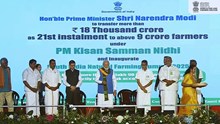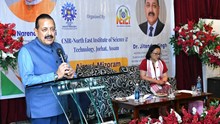
The Indian government has introduced the Digital Farmer IDs, also known as Kisan Pehchan Patra, to streamline the delivery of agricultural benefits and ensure that genuine farmers receive the support they need. This initiative is a key component of the Digital Agriculture Mission, which aims to digitize the agricultural sector and enhance transparency in the distribution of subsidies and welfare schemes
The unique digital identity helps farmers across the country access government services more efficiently. According to the Ministry of Agriculture and Farmers Welfare, as of March 28, 2025, a total of 4,85,57,246 Farmer IDs have been issued. Here's everything you need to know about the Farmer ID.
What is a Farmer ID?
A Farmer ID is a unique, Aadhaar-linked digital identity assigned to individual farmers. It connects a farmer's personal information with land records, crop details, and farming activities. Much like the Aadhaar system, the Farmer ID helps verify the identity of beneficiaries applying for various agricultural schemes, ensuring that only genuine land-owning farmers receive government benefits. This reduces fraudulent claims and improves the overall efficiency of welfare programs.
This initiative is a core part of the AgriStack project, launched under the Government of India’s Digital Agriculture Mission. Its primary goal is to build a centralized and comprehensive database of farmers, enabling more targeted and timely delivery of services.
The Digital Agriculture Mission, approved in September 2024 with a total outlay of Rs 2,817 crores, focuses on building a robust digital ecosystem for Indian agriculture. As part of this mission, a Digital Public Infrastructure (DPI) is being developed, comprising AgriStack, the Krishi Decision Support System, and a comprehensive Soil Fertility & Profile Map. These digital tools are expected to drive innovation in the sector, empower farmers with timely crop-related insights, and enhance decision-making at both individual and policy levels.
The AgriStack DPI is built on three foundational registries:
-
Geo-Referenced Village Maps
-
Crop Sown Registry
-
Farmers Registry
All of these databases are created and maintained by the respective State Governments or Union Territories, forming the backbone of India’s digital agriculture framework.
Benefits of Having a Farmer ID
Possessing a Farmer ID offers numerous advantages that simplify and enhance access to agricultural support and services:
-
Access to Government Schemes: Farmers can easily avail benefits from various central and state schemes like the PM-Kisan Samman Nidhi Yojana, crop insurance programs, and the Kisan Credit Card (KCC) without undergoing repeated verifications.
-
Subsidies and Financial Aid: The ID enables direct transfer of subsidies for seeds, fertilizers, machinery, and other farm inputs, ensuring timely and transparent financial support.
-
Efficient Service Delivery: It minimizes paperwork and reduces the need for physical visits, making processes like loan approvals and insurance claims quicker and more accessible.
-
Simplified Crop Insurance: Enrolling in crop insurance becomes easier, helping farmers safeguard against losses due to weather events, pests, or natural disasters.
-
Easy Access to Loans and Credit: Banks and financial institutions can promptly verify the farmer’s credentials, speeding up the process of providing agricultural loans and credit facilities.
-
Transparency and Accountability: The system helps reduce corruption by ensuring benefits reach the rightful beneficiaries, promoting fairness and efficiency in service delivery.
-
Financial Inclusion: A verified digital identity empowers farmers to participate more actively in the formal financial system, boosting economic resilience within the farming community.
How to Apply for a Farmer ID
The application process for obtaining a Farmer ID may vary slightly across states, but it generally involves the following steps:
1. Online Registration: Farmers need to register on the official agricultural portal of their respective state. For example, in Uttar Pradesh, farmers can apply through the state's dedicated service portal: upfr.agristack.gov.in. Alternatively, they can download apps like Farmer Registry UP, FCRD Service, or eHastakshar for self-registration.
2. Providing Necessary Documents: Applicants must submit essential documents, including:
-
-
Land ownership records (e.g., Khatauni)
-
Bank account details
-
A recent photograph
It is important for farmers to be present in person during the registration process to ensure accurate data collection.
3. Verification Process: The submitted information will be verified by the relevant authorities to confirm the applicant's eligibility for the Farmer ID.
4. Issuance of Farmer ID: After successful verification, a unique Farmer ID will be generated and issued, allowing farmers to access various agricultural services and benefits.
Farmers can also visit the nearest Common Service Center (CSC) for assistance with registration or participate in registration camps organized by agricultural departments at the village or block level.
Implementation Timeline and Coverage
The government has set an ambitious goal to create Digital Farmer IDs for approximately 110 million farmers in the coming years. The rollout will take place in phases:
-
2024-25: 60 million farmers
-
2025-26: 30 million farmers
-
2026-27: 20 million farmers
Several states have already started implementing the Farmer ID system. For example, Maharashtra will require farmers to use Farmer IDs starting April 15, 2025, to access government schemes. This move aims to improve the efficiency of benefit distribution. Similarly, Karnataka uses the FRUITS platform to manage farmer identities and simplify access to agricultural benefits.
Starting January 1, 2025, the Digital Farmer ID will be mandatory for new applicants of the PM-Kisan scheme in states like Uttar Pradesh. This requirement will be gradually extended to other states in the following phases.
The introduction of Farmer IDs marks a significant step toward digitizing India’s agricultural sector. By providing farmers with a unique identity, the government aims to ensure that agricultural benefits are distributed fairly and efficiently. This initiative seeks to reduce the potential for fraud and enhance the overall welfare of the farming community.
Farmers are encouraged to register for their Farmer IDs promptly in order to take full advantage of the available schemes and support systems.
















